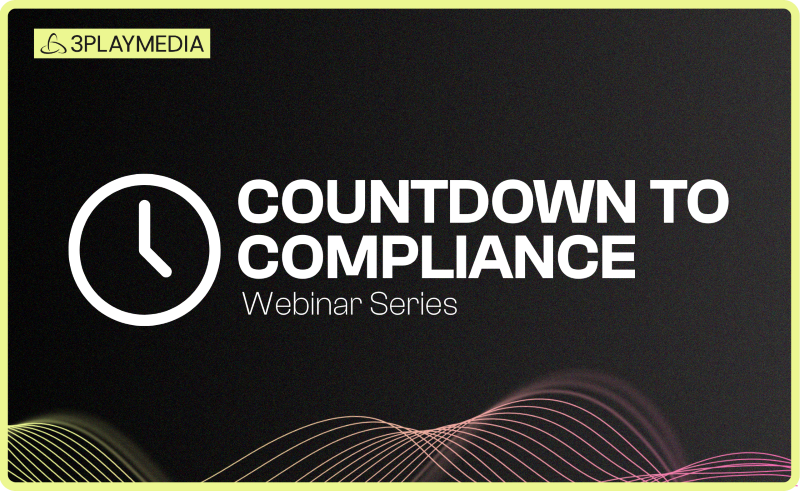- Audio Description
How to Make Your Captions and Audio Descriptions WCAG-Compliant
•

A Practical Guide to WCAG Video Accessibility Requirements [Free eBook]
With digital accessibility lawsuits on the rise, compliance with Web Content Accessibility Guidelines (WCAG) 2.2 is crucial for any organization with a web presence.
While there are many aspects to WCAG, captions and audio descriptions are among the easiest accessibility requirements to implement for a WCAG-compliant, inclusive, and user-friendly video experience.
But what exactly constitutes a WCAG-compliant video?
In this blog, we’ll provide an overview of the current WCAG standards for captions and audio descriptions, what makes them WCAG-compliant, the major lawsuits and settlements referencing these standards, and the direction WCAG compliance could take going forward.
The Standard: WCAG 2.0 Level AA

If you hear the term “WCAG compliant,” there’s a good chance it’s referring to WCAG 2.0 Level AA. That’s because, for years, WCAG 2.0 Level AA has been considered the primary standard for web accessibility.
WCAG 2.0 Level AA is also the most commonly referenced standard in accessibility laws and policies around the globe and in the U.S. — including Section 508 of the Rehabilitation Act.
To achieve WCAG 2.0 Level AA conformance, Level A standards must also be met. Below are captioning and audio description requirements for Levels A, AA, and AAA:
- Level A: (1.2.2) Captions are provided for all prerecorded audio content in synchronized media, except when the media is a media alternative for text and is clearly labeled as such. (1.2.3) An alternative for time-based media or audio description of the prerecorded video content is provided for synchronized media, except when the media is a media alternative for text and is clearly labeled as such.
- Level AA: In addition to Level A compliance: (1.2.4) Captions are provided for all live audio content in synchronized media. (1.2.5) Audio description is provided for all prerecorded video content in synchronized media.
- Level AAA: In addition to Level A and AA compliance: (1.2.6) Sign language interpretation is provided for all prerecorded audio content in synchronized media. (1.2.7) Where pauses in foreground audio are insufficient to allow audio descriptions to convey the sense of the video, extended audio description is provided for all prerecorded video content in synchronized media.
If you are trying to meet WCAG 2.0 Level AA standards, captions must be provided for both recorded and live video or audio content. To meet Level AA audio description requirements, audio descriptions must be “provided for all prerecorded video content in synchronized media.”
Want to go above and beyond standard WCAG 2.0 compliance? In addition to all of the A and AA requirements, sign language interpretation is needed for all recorded video or audio content. Extended audio descriptions are also required for videos with insufficient space for standard audio descriptions. That being said, the World Wide Web Consortium (W3C) notes: “It is not recommended that Level AAA conformance be required as a general policy for entire sites because it is not possible to satisfy all Level AAA Success Criteria for some content.”
The WCAG 2.2 and 2.1 levels of compliance for captioning and audio description remain the same as 2.0. For example, if you achieve WCAG 2.0 Level AA compliance for captioning and audio description, you have also achieved 2.1 Level AA or 2.2 Level AA compliance for these aspects, but you may not have achieved overall 2.1 or 2.2 Level AA for the entirety of your website.
WCAG 2.1 and 2.2 do have differences from 2.0, but these differences do not apply to captioning or audio description at this time. Overall, W3C recommends using the latest WCAG standards to best achieve optimal website accessibility.
What makes captions or descriptions WCAG-compliant?

W3C, the group that authored WCAG, does not have exact compliance metrics for measuring the quality of captions and descriptions. This can make it tricky to know exactly what being WCAG-compliant means when it comes to video accessibility.
For example, an organization may be searching for particular metrics that dictate captions must be X percent accurate, or that descriptions must be X long or contain X amount of detail. But these metrics do not exist for WCAG at this time.
Instead, WCAG takes a broader approach to accessibility by requiring all web content to obey each of the POUR principles:
- Perceivable: Information and user interface components must be presentable to users in ways they can perceive.
- Operable: User interface components and navigation must be operable.
- Understandable: Information and the operation of user interface must be understandable.
- Robust: Content must be robust enough that it can be interpreted reliably by a wide variety of user agents, including assistive technologies.
WCAG was designed around these four principles of accessibility to ensure that web content can be used by anyone.
How to achieve WCAG-compliant captions and audio descriptions
Fortunately, organizations have a global pool of resources and quality standards to pull from to ensure high-quality, WCAG-compliant captioning and audio description services.
General industry and compliance standards have been developed over time by accessibility experts and industry leaders, such as the Americans with Disabilities Act (ADA), the Federal Communications Commission (FCC) quality standards, the 21st Century Communications and Video Accessibility Act (CVAA), and the Accessibility for Ontarians with Disabilities Act (AODA).
Captioning
3Play Media follows captioning best practices using information from the Described and Captioned Media Program’s (DCMP) Captioning Key, the FCC’s captioning quality standards for video programming, the expertise of tenured live and recorded captioners, and more.
Audio Description
3Play Media follows audio description best practices that draw from the DCMP Description Key, the American Council for the Blind’s (ACB) Audio Description Project (ADP), and the expertise of our tenured describers and voice actors.
Do your web videos comply with WCAG 2.1? ⏯️
Legal Settlements Referencing WCAG

WCAG has been increasingly referenced in ADA-based lawsuits and settlements over the past decade. While it is not directly part of ADA legislation yet, the U.S. Department of Justice (DOJ) often points to WCAG guidelines as an example of what standards organizations need to meet for optimal captioning and audio description compliance.
The Biden-Harris administration has additionally signaled their alignment with WCAG guidelines, specifically calling out WCAG 2.1 Level AA compliance in the White House’s web accessibility statement.
edX
In 2015, edX, the online learning platform co-owned by Harvard and MIT, settled a complaint from the DOJ about accessibility issues on the edX website including failure to provide accurate and comprehensive captioning across video content in the platform’s courses.
edX agreed to make their website fully accessible, develop a web accessibility policy, and urge course providers to make web content accessible before publishing to edX. In this case, WCAG 2.0 Level AA was referenced as the standard for web accessibility practices including captioning.
Netflix
Netflix was sued by the ACB for not providing audio description on their streaming movies and shows. Netflix settled with ACB in 2016. This settlement agreement also adopted the WCAG 2.0 Level AA as the accessibility standard for audio description which Netflix would need to meet in remediating their video content. In the years since, Netflix has become one of the most dominant providers of streaming audio description on the web.
UC Berkeley
In December 2022, UC Berkeley and the DOJ entered into an agreement after an eight-year investigation into the accessibility of UC Berkeley’s online content. The Consent Decree requires UC Berkeley to make all online content accessible.
While the initial investigation mainly applied to the university’s MOOC, UC BerkeleyX, the Consent Decree broadened the scope of affected online content to additionally include all publicly accessible websites on berkeley.edu and subdomains, as well as content published by UC Berkeley on third-party platforms like YouTube, Spotify, or Apple Podcasts. The settlement requires UC Berkeley to work towards making all digital media content conform to WCAG 2.0 Level AA standards.
The Future of WCAG Compliance

Further web and streaming-focused accessibility guidelines are expected in the near future, with the DOJ recently announcing its intent to strengthen web and mobile accessibility under Title II of the ADA:
Details of the proposed rule were made available on August 3, 2023. Read the full Notice of Proposed Rulemaking (NPRM) or review the ADA’s Fact Sheet on the NPRM.
Based on past lawsuits and aforementioned settlements, most experts anticipated that U.S. guidelines would draw from WCAG 2.0 or 2.1 Level AA standards, and the NPRM does in fact reference WCAG 2.1 Level AA as the technical standard state and local governments would need to follow.
It is important to remember that this proposed rule is just that… for now. The DOJ is soliciting feedback about the proposal through October 3, 2023, and encourages folks to submit their thoughts via regulations.gov or directly mailing comments to the DOJ.
This blog was originally published Patrick Loftus on April 24, 2018, as “How to Produce WCAG-Compliant Video Captions and Audio Descriptions” and has since been updated for comprehensiveness, clarity, and accuracy.
This blog post is written for educational and general information purposes only, and does not constitute specific legal advice. This blog should not be used as a substitute for competent legal advice from a licensed professional attorney in your state.
Filed under
About the author
Share this page
Related Posts
-
 Read more: A University Guide to Budgeting and Auditing for ADA Video Compliance
Read more: A University Guide to Budgeting and Auditing for ADA Video Compliance- Legislation & Compliance
A University Guide to Budgeting and Auditing for ADA Video Compliance
-
 Read more: Everything to Know About the Americans with Disabilities Act (ADA) and Video Compliance
Read more: Everything to Know About the Americans with Disabilities Act (ADA) and Video Compliance- Legislation & Compliance
Everything to Know About the Americans with Disabilities Act (ADA) and Video Compliance
-
 Read more: Subtitling vs. Dubbing: Which is Right for Your Audience?
Read more: Subtitling vs. Dubbing: Which is Right for Your Audience?- Subtitling
Subtitling vs. Dubbing: Which is Right for Your Audience?



